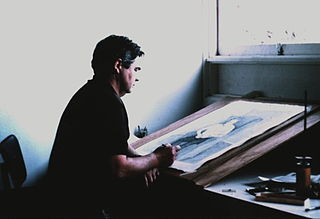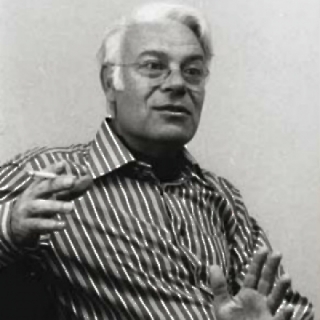
John Brack was an Australian painter, and a member of the Antipodeans group. According to one critic, Brack's early works captured the idiosyncrasies of their time "more powerfully and succinctly than any Australian artist before or since. Brack forged the iconography of a decade on canvas as sharply as Barry Humphries did on stage."
Janet Laurence is an Australian artist, based in Sydney, who works in photography, sculpture, video and installation art. Her work is an expression of her concern about environment and ethics, her "ecological quest" as she produces art that allows the viewer to immerse themselves to strive for a deeper connection with the natural world. Her work has been included in major survey exhibitions, nationally and internationally and is regularly exhibited in Australia, Japan, Germany, Hong Kong and the UK. She has exhibited in galleries and outside in site-specific projects, often involving collaborations with architects, landscape architects and environmental scientists. Her work is held in all major Australian galleries as well as private collections in Australia and overseas.

Grahame Edwin King was a master Australian printmaker, who has been called the "patron saint of contemporary Australian printmaking". He was responsible for the revival of print making in Australia in the 1960s. He helped set up the Print Council of Australia, of which he was the first Honorary Secretary and was later President. He taught printmaking at The Royal Melbourne Institute of Technology (RMIT) from 1966 to 1988. In 1991, he was awarded an Order of Australia for his services to education. As well as teaching, King produced his own art work, concentrating on lithographs and monotypes. He was also a skilled photographer and used his photography both in his teaching and in his practice.

John Puhiatau Pule is a Niuean artist, novelist and poet. The Queensland Art Gallery describes him as "one of the Pacific's most significant artists".

Gareth Sansom is an Australian artist, painter, printmaker and collagist and winner of the 2008 John McCaughey Memorial Prize of $100,000.
Anne Zahalka is an Australian photo media artist (photographer). She was born to a Jewish Austrian mother and Catholic Czech father. Her parents met and married in England during the Second World War. Zahalka subsequently developed an interest in Australia's migrants and diverse cultures.
Tony Lloyd is an Australian contemporary artist. Lloyd's paintings are influenced by cinema, in particular Film Noir and Science Fiction, and the Romantic conception of the sublime. Lloyd's largely monochromatic paintings are realist in style.
Vaughan Murray Griffin (1903–1992) was an Australian print maker and painter.
Jill Orr is a contemporary artist based in Melbourne, Australia, whose works have been exhibited around the world.
Diane Mantzaris is an Australian artist known for her pioneering application of digital imaging to printmaking and for her unconventional approach to image making, which is often both personal and political in content. Mantzaris pioneered the use of computers as a printmaking and art-making tool in the early to mid-1980s, exhibiting widely, nationally and throughout Asia in touring exhibitions, to considerable acclaim. Her practice now crosses into several fields associated with the visual arts, printmaking, drawing, photography, sculpture, performance and public art. She is represented in most state and public collections throughout Australia and significant private collections throughout Asia and Europe.
Robert Rooney (1937–2017) was an artist and art critic from Melbourne, Australia, and a leading figure in Australian Conceptual art.
Terry Batt is an Australian artist and sculptor.

Udo Sellbach (1927–2006) was a German-Australian visual artist and educator whose work focused primarily around his printmaking practice.

Ronnie van Hout is a New Zealand artist, living in Melbourne, Australia. He works across a wide variety of media including sculpture, video, painting, photography, embroidery, and sound recordings.
Andrew John Sibley was an English-born Australian artist. Sibley has been the subject of three books and is commonly listed in histories and encyclopedias of Australian art as a significant figurative painter of the mid and late 20th century.
Kate Just is an American-born Australian artist.
Elizabeth Gower is an Australian abstract artist who lives and works in Melbourne. She is best known for her work in paper and mixed-media monochrome and coloured collages, drawn from her sustained practice of collecting urban detritus.
Joan Grounds is an American-born artist. She has been exhibiting in Australia and internationally from 1967. Her solo and collaborative art work is held in the National Gallery of Australia (ceramics), the National Gallery of Victoria and in the Powerhouse Museum of Arts and Applied Sciences (ceramics). Her hybrid practice incorporated ceramics, sculpture, sound art, film and performance art.
Jan Nelson is an Australian artist who works in sculpture, photography and painting. She is best known for her hyper real images of adolescents. She has exhibited widely in Australia as well as Paris and Brazil. Her works are in the collections of Australian galleries including the National Gallery of Australia, National Gallery of Victoria, Art Gallery of New South Wales, Museum of Contemporary Art, Sydney and the Gallery of Modern Art Brisbane, as well as major regional galleries. She represented Australia in the XXV biennale in São Paulo, Brazil.
Angela Cavalieri is an Australian printmaker.






